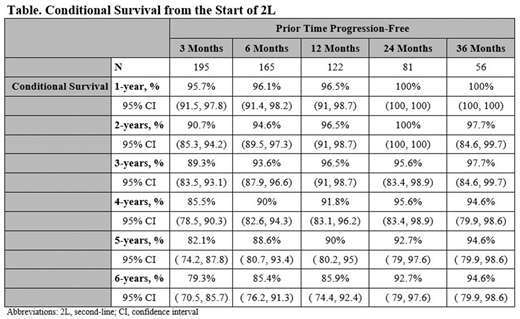Introduction:While the majority of patients (pts) with newly diagnosed classical Hodgkin's lymphoma (cHL) achieve remission following first-line therapy, approximately 30-40% will relapse or become refractory (R/R). Despite R/R status, the 5-year relative survival rate in this population is high (ranging from 78% to 92%) (American Cancer Society 2020). While overall survival (OS) is an unambiguous measure of efficacy in clinical trials, using it as a primary end point requires a long duration of follow-up and may prolong the process of identifying novel and potentially beneficial therapy. Surrogate outcomes, such as progression-free survival (PFS) and time to progression (TTP) are sometimes regarded as valid alternatives when assessing efficacy of a treatment in the absence of mature OS data. The objectives of this study were to assess the conditional survival (CS) given prior PFS among R/R cHL pts treated in the real-world setting.
Methods:This retrospective cohort study used electronic medical record (EMR) data of US pts from a network of oncology practices, including practices affiliated with CancerLinQ, maintained in the Definitive Oncology Dataset. Eligible adult (≥18 years) pts who had a confirmed diagnosis of cHL and ≥1 R/R event that occurred between 2000 to 2019 were included. Refractory disease was defined as not achieving a complete or partial response (CR or PR) during a line of therapy. Relapsed disease was defined as the reappearance of cHL at any time after the end of treatment after having achieved a CR or PR. PFS and OS were measured from the start of second-line [2L] therapy to the earlier or disease progression or death; pts without evidence of disease progression or death were censored at the last observed visit. The association between PFS and OS was quantified through the nonparametric Kendall tau rank correlation for bivariate censored data. CS was defined as the Kaplan-Meier probability of surviving an additionalymonths (from the start of 2L), given no OS or PFS event in the previousx(< y) months.
Results:A total of 286 R/R cHL pts were included. Most pts were Caucasian (77.3%, n=221) with a median age of 35 years (range: 19-86) at the first R/R event. Median length of follow-up was 12 months from the first R/R event. The most common B symptoms reported were night sweats (38.8%, n=111), weight loss (36.4%, n=104), and fatigue (27.3%, n=78). More than half of pts (54.9%, n=157) received autologous stem-cell transplant (SCT) and 6.6% (n=19) received allogenic SCT. Two-hundred twenty-six pts (79.0%) had documented 2L therapy (first R/R event). From the first R/R event, among these 226 pts, median PFS was 21.0 months (95% confidence interval [CI]: 15.1, 52.5) and median OS was 146.7 months (95% CI: 119.9, not achieved [NA]). CS rates among pts alive without disease progression increased with time: 1-year and 6-year survival rates were 95.7% (95% CI: 91.5, 97.8) and 79.3% (95% CI: 70.5, 85.7), respectively, in pts alive without progression at 3 months, but increased to 100.0% (95% CI: 100, 100) and 94.6% (95% CI: 79.9, 98.6) in pts alive without progression at 3-years (Table). The calculated Kendall tau correlation was 0.42 (p<0.0001), which suggested a statistically significant dependence between PFS and OS.
Conclusion:In the real-world setting, R/R cHL pts with longer time without disease progression had lower rates of death and better prognosis. Results from this study support a relationship between PFS and OS; however, further validation and acceptance of PFS as a surrogate endpoint in cHL is required. Establishing these relationships may inform future clinical trial design and interpretation of interim trial data.
Desai:Merck & Co., Inc:Current Employment, Current equity holder in publicly-traded company.Yang:Merck & Co, Inc.:Current Employment.Gilligan:ConcertAI:Current Employment;Merck & Co., Inc.:Research Funding.Li:Merck & Co., Inc.:Current Employment, Current equity holder in publicly-traded company.Raut:Merck & Co., Inc.:Current Employment.Nahar:Merck Sharp & Dohme, Corp., a subsididary of Merck & Co., Inc., Kenlworth, NJ, USA:Current Employment.
Author notes
Asterisk with author names denotes non-ASH members.


This feature is available to Subscribers Only
Sign In or Create an Account Close Modal